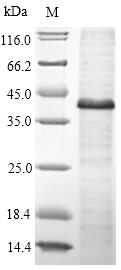Recombinant Human Protein Wnt-5a (WNT5A) is produced through an E.coli expression system and covers the complete mature protein sequence from amino acids 62 to 380. The protein includes both an N-terminal 10xHis-tag and a C-terminal Myc-tag, which appears to streamline both detection and purification processes. SDS-PAGE analysis confirms purity levels exceeding 90%, though this may still leave room for minor contaminants that could affect certain sensitive applications.
Wnt-5a belongs to the Wnt protein family, a group that seems to play crucial roles in cell-to-cell communication throughout embryonic development. Unlike canonical Wnt signaling, Wnt-5a is likely involved in non-canonical pathways that influence cell movement and polarity establishment. While research into Wnt-5a has revealed important connections to developmental biology, scientists are still uncovering its broader physiological roles and potential involvement in disease processes.
Potential Applications
Note: The applications listed below are based on what we know about this protein's biological functions, published research, and experience from experts in the field. However, we haven't fully tested all of these applications ourselves yet. We'd recommend running some preliminary tests first to make sure they work for your specific research goals.
Based on the provided information, the recombinant human WNT5A is expressed in E. coli, a prokaryotic system that is fundamentally unsuitable for producing functional eukaryotic signaling proteins like WNT5A. WNT proteins require precise folding, multiple disulfide bond formations, and essential lipid modifications (particularly palmitoylation) for their biological activity and receptor binding capability. E. coli lacks the eukaryotic chaperones, disulfide isomerases, and modification machinery necessary for proper WNT protein folding and processing. The protein is expressed as the mature region (62-380aa) with dual tags (N-terminal 10xHis and C-terminal Myc), but this represents only the polypeptide chain without critical post-translational modifications. The >90% purity indicates low contamination but does not confirm proper folding. Since activity is unverified and WNT proteins are notoriously difficult to express correctly in prokaryotic systems, the protein is highly likely to be misfolded, unlipidated, and inactive without experimental validation.
1. Antibody Development and Validation Studies
The recombinant WNT5A can serve as an effective immunogen for generating antibodies that recognize linear epitopes within the 62-380aa region, even if the protein is misfolded. The dual tags provide additional epitopes for characterization. However, antibodies may not recognize conformational or lipid-dependent epitopes of properly folded, modified native WNT5A. Validation against endogenous WNT5A from mammalian cells is essential.
2. Protein-Protein Interaction Studies Using Tag-Assisted Pull-Down Assays
This application is highly problematic without folding validation. If WNT5A is misfolded (as expected in E. coli), it will not interact physiologically with its receptors (Frizzled, ROR2) or regulatory proteins. The multiple disulfide bonds required for proper WNT structure are unlikely to form correctly in E. coli. Identified interactions would likely be non-physiological artifacts of the tags or misfolded protein. This application should not be pursued without confirmation of proper folding and receptor-binding activity.
3. ELISA-Based Quantitative Binding Assays
This application should be avoided without functional validation. If WNT5A is misfolded and unlipidated, it will not bind to its natural receptors with correct affinity or specificity. ELISA assays would yield misleading quantitative data that does not reflect biological reality. This application requires prior demonstration of proper folding and receptor activation capability.
4. Biochemical Characterization and Stability Studies
This application is well-suited for assessing the recombinant human WNT5A protein itself. Techniques like circular dichroism spectroscopy, size-exclusion chromatography, and thermal shift assays can evaluate the protein's folding state and stability. However, these will characterize the E. coli-expressed product, which likely differs significantly from native, properly modified WNT5A. These studies are valuable for quality control but cannot validate biological activity.
Final Recommendation & Action Plan
Given the extreme challenges of producing functional WNT proteins in E. coli, recommend the following approach: First, perform extensive biophysical characterization (circular dichroism for secondary structure, non-reducing SDS-PAGE for disulfide bond analysis) to assess folding quality. Antibody development can proceed as the safest application. Completely avoid all functional studies (interactions, binding assays) unless proper folding and biological activity are conclusively demonstrated through receptor-binding assays. For reliable WNT5A research, obtain the protein from mammalian or insect cell expression systems capable of proper disulfide bond formation and lipidation. Always include appropriate controls, such as active, properly modified WNT5A, when possible.






